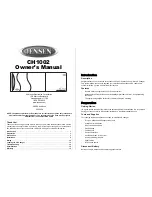
The hot-start functionality is of particular benefit to vehicle tracking and robotics applications. The primary
benefits are immunity and fast recovery from power failure as well as fast start up time.
7.3 Time
GNSS Compass has been designed to provide a highly accurate time reference. It contains a temperature
compensated disciplined oscillator that corrects itself very precisely using GNSS time. When a GNSS fix is
available, the GNSS Compass time is accurate to within 20 nanoseconds.
When GNSS Compass hot-starts the time accuracy is typically within 1 second immediately on startup and
corrected to within 50 nanoseconds as soon as a GNSS fix is achieved.
The time can be accessed via the following means:
l
For Serial variants, part number GC2-SER. A dedicated
. This is the preferred means to
obtaining the most accurate timing output.
l
For Ethernet variants, part number GC2-POE. A built-in Precision Time Protocol (PTP) version 2 server
for synchronisation with network-connected devices which require high accuracy time. The PTP server
broadcasts PTP messages (Sync, Follow Up, Announce) to multicast IP address 224.0.1.129. The PTP
broadcasts are sent whenever an Ethernet connection is established and cannot be disabled.
l
For Ethernet variants, part number GC2-POE. A built-in Network Time Protocol (NTP) server.
7.4 Heading Sources
There are several different heading sources available for GNSS Compass . The heading sources can be
configured using the Filter Options page in the Web UI (see
8.1 Using the Web User Interface
or in the
Manager application (see
8.2 Using GNSS Compass Manager
). It is possible to use multiple heading sources
and this can provide performance benefits.
7.4.1 Dual Antenna Heading
This is the default heading source and provides the most accurate heading while GNSS is available. Dual
antenna heading only works when a good GNSS fix is available to both antennas. It requires a clear view of the
sky with minimal nearby sources of interference or multipath.
7.4.2 External Heading
This can be used if there is some other way to derive heading that is external to GNSS Compass. The heading
must be supplied to GNSS Compass using the
10.4.29 External Heading Packet
or an NMEA message, see
.
7.5 NMEA 2000
The GNSS Compass serial variant (GC2- SER) permanently outputs the NMEA 2000 messages on the
CAN port as listed below. It is not possible to modify this configuration:
v2.0
Page 31
04 Nov 2021
GNSS Compass Reference Manual • Using GNSS Compass
Summary of Contents for GNSS Compass
Page 1: ...GNSS Compass Reference Manual v2 0 04 Nov 2021 ...
Page 28: ......
















































